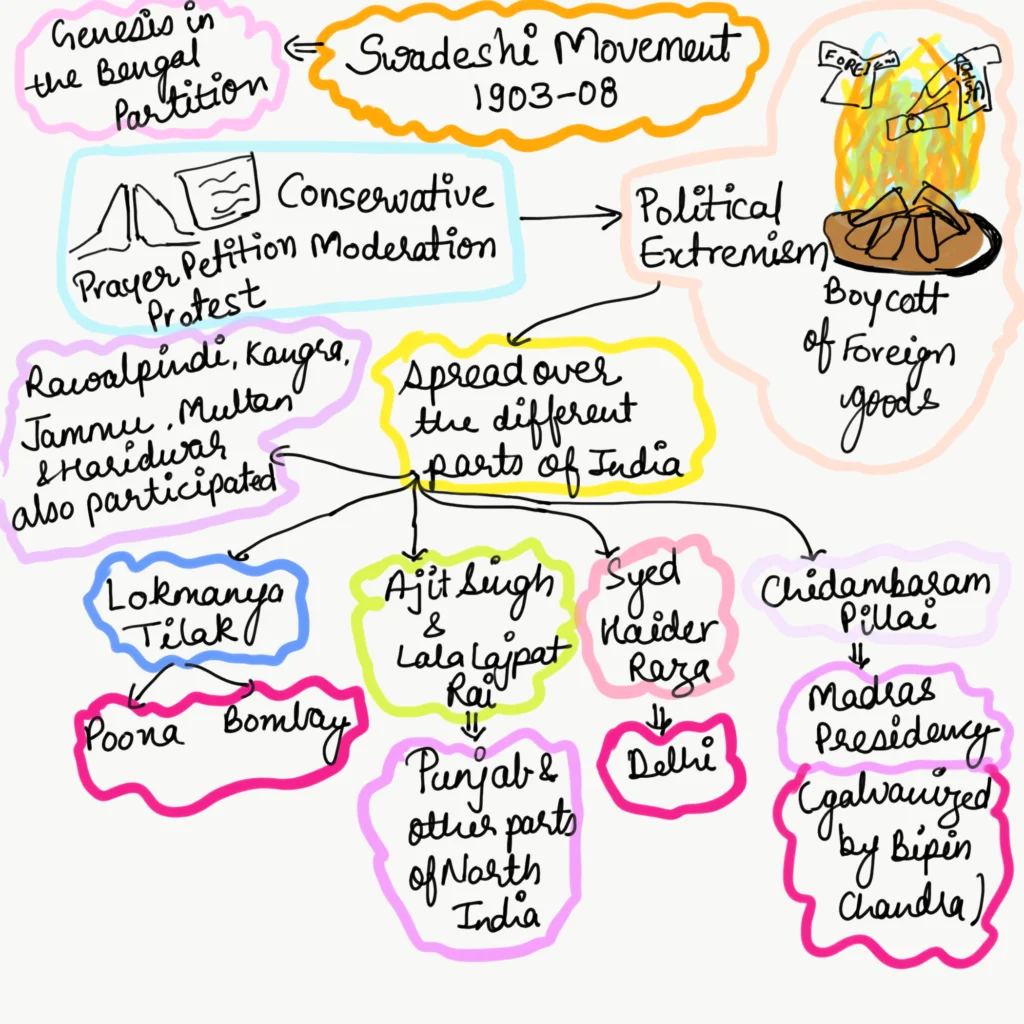Militant nationalists introduced innovative strategies during the freedom movement. Their approaches included revolutionary ideology, extensive propaganda, advocating boycotts and the Swadeshi movement, and forming secret societies for coordinated actions, aiming to challenge British colonial rule and advance the cause of independence. It showcased a more radical approach, emphasising a complete rejection of involvement in institutions that supported British rule, aiming to make the administration unworkable and ultimately striving for India’s complete freedom from foreign governance.
Boycott of Foreign Goods
Diverse Strategies: The movement’s boycott of foreign goods encompassed various impactful actions: Rejecting and publicly burning foreign textiles, abstaining from foreign-produced salt or sugar, urging priests to refrain from conducting marriage rituals involving foreign goods, and encouraging washermen to decline washing foreign clothes.
- Widespread Public Support: This collective protest resonated strongly with the public, achieving significant practical success and widespread popularity.
Public Gatherings and Processions
Primary Mass Mobilization: These emerged as significant tools for mass mobilisation within the nationalist movement. These events served as vital means to rally the masses and foster a sense of unity and collective purpose.
- Expression of Popular Sentiments: Simultaneously, these gatherings provided a platform for the expression of popular sentiments, allowing individuals to voice their support for the cause of independence and actively participate in the movement.
“Corps of Volunteers” or ‘Samitis’:
- The “Corps of Volunteers” or ‘Samitis’ played a crucial role in India’s freedom movement, particularly in fostering political consciousness among the masses and encouraging nationalist sentiment.
- Role: These samitis were local organisations that engaged in various activities aimed at mobilising people and spreading the message of swadeshi (self-reliance) and freedom from colonial rule.
- Swadesh Bandhab Samiti of Ashwini Kumar Dutta: This samiti, based in Barisal, was a prominent group that effectively mobilised people. They used various strategies such as magic lantern lectures, swadeshi songs, physical and moral training, social work during famines and epidemics, organising schools, training in swadeshi crafts, and establishing arbitration courts. These activities were aimed at not only spreading awareness but also at building a self-reliant society capable of managing its affairs independently.
- Swadeshi Sangam in Tirunelveli, Tamil Nadu: V.O. Chidambaram Pillai, Subramania Siva, and lawyers formed the Swadeshi Sangam. This group also focused on inspiring local masses by utilising similar strategies as the Samiti in Barisal.
- They used cultural events, such as magic lantern lectures, traditional festivals, and social work to spread the message of swadeshi and freedom from colonial rule.
Public Celebration of Festivals
- Tilak’s Ganapati and Shivaji Festivals: These traditional festivals, popularised by leaders like Bal Gangadhar Tilak, were transformed into platforms for swadeshi propaganda.
- The celebrations were used not only to honour the deities but also to disseminate nationalist ideals and encourage self-reliance.
- Bengal’s Traditional Folk Theatre Forms: These traditional art forms were used as a medium to convey political messages and nationalist ideals.
- They became a part of the freedom movement’s narrative, allowing the ideas of self-governance and independence to reach the masses in a culturally resonant manner.
Atma-Shakti
- National Pride and Self-Reliance: Promoting ‘atma shakti’ or self-reliance during India’s struggle for independence involved a resurgence of national pride, the restoration of dignity and confidence, and the revival of social and economic well-being within villages.
- Social Reforms and Campaigns: In practical terms, this philosophy encompassed initiatives focused on social reforms and campaigns against oppressive practices like caste discrimination, early marriages, the dowry system, and alcohol consumption.
- Social Equity: These efforts aimed to transform societal norms and practices, fostering a more equitable and empowered society while advocating for self-sufficiency and local development.
Programme of Swadeshi or National Education
Bengal National College: The Bengal National College, inspired by Rabindranath Tagore’s Shantiniketan, was founded as an institution that aimed to provide education rooted in Indian culture, values, and traditions.
- Aurobindo Ghosh served as its principal, and it became a symbol of the Swadeshi movement’s commitment to indigenous education.
- National Schools and Colleges: Following the establishment of Bengal National College, similar national schools and colleges were set up in different parts of the country.
-
- These institutions were dedicated to promoting Indian culture and heritage, providing an alternative to the British colonial education system that was seen as alien and oppressive.
- National Council of Education: The National Council of Education was established on August 15, 1906, to organize an education system that covered literary, scientific, and technical education along nationalistic lines and under Indian control.
- One of the key principles of this system was the use of vernacular languages as the medium of instruction, making education accessible and relevant to the masses.
- Bengal Institute of Technology: In addition to literary and scientific education, technical education was given importance.
- The Bengal Institute of Technology was established to cater to the growing need for technical skills, aligning with the Swadeshi movement’s emphasis on self-reliance and industrial development.
- Sending Students to Japan: To provide students with advanced learning opportunities, funds were raised to send them to Japan.
- This move aimed to expose Indian students to technological and industrial advancements in a global context and equip them with the knowledge and skills necessary for India’s progress.
Swadeshi Enterprises
Textile Mills, Soap and Match Factories, Tanneries, Banks, Insurance Companies, Shops: The Swadeshi movement inspired the establishment of various indigenous industries such as textile mills, soap and match factories, tanneries, banks, insurance companies, and shops.
- These enterprises were driven more by patriotic fervour than by business acumen. The aim was to reduce dependence on imported goods and promote locally produced items.
- V.O. Chidambaram Pillai’s Swadeshi Steam Navigation Company: Chidambaram Pillai’s venture in establishing the Swadeshi Steam Navigation Company in Tuticorin posed a challenge to the British India Steam Navigation Company.
-
- This initiative demonstrated an attempt to compete with established British interests in the shipping industry.
Impact on Culture
The movement had a significant impact on the cultural arena. Several songs composed during this time by stalwarts from the field including Rabindranath Tagore, Makunda Das, Dwijendralal Ray, Syed Abu Mohammad, and Rajani Kanta Sen became extremely popular infusing Indian nationalism among people.

- Inspiration from Nationalist Songs: Nationalists drew inspiration from the songs written by prominent figures like Rabindranath Tagore, Rajnikant Sen, Dwijendralal Ray, Mukunda Das, Syed Abu Mohammad, and others. Tagore’s “Amar Sonar Bangla” later became the national anthem of Bangladesh, inspiring its liberation struggle.
- In Tamil Nadu, Subramania Bharati wrote “Sudesha Geetham,” which resonated with the spirit of Swadeshi.
- Abanindranath Tagore in Painting: Abanindranath Tagore played a pivotal role in challenging the dominance of Victorian naturalism in Indian art.
- He drew inspiration from Indian art forms such as Ajanta, Mughal, and Rajput paintings, ushering in a new wave of indigenous artistic expression.
- Nandalal Bose and the Indian Society of Oriental Art: Nandalal Bose, a significant figure in Indian art, was the first recipient of a scholarship offered by the Indian Society of Oriental Art, established in 1907.
- His work and contributions left a lasting imprint on Indian art.
- Scientific Contributions: Figures like Jagdish Chandra Bose, Prafullachandra Roy, and others made significant strides in original scientific research.
- Their contributions were recognized globally, showcasing India’s capability for scientific innovation and discovery.
- Revival of Traditional Crafts: Swadeshi emphasized the importance of traditional Indian crafts and industries.
-
- The promotion of handwoven textiles, pottery, handcrafted goods, and indigenous industries helped revive traditional craftsmanship and employed many artisans.
| Must Read | |
| Current Affairs | Editorial Analysis |
| Upsc Notes | Upsc Blogs |
| NCERT Notes | Free Main Answer Writing |
Conclusion
The militant nationalist movement revolutionized the struggle for Indian independence by embracing radical methods that fostered mass mobilization, cultural resurgence, and economic self-reliance. Through boycotts, public gatherings, educational reforms, and the promotion of indigenous industries, this movement not only challenged British colonial rule but also cultivated a strong sense of national pride and unity. These efforts laid a robust foundation for India’s eventual triumph in achieving freedom from foreign domination.
Sign up for the PWOnlyIAS Online Course by Physics Wallah and start your journey to IAS success today!

 GS Foundation
GS Foundation Optional Course
Optional Course Combo Courses
Combo Courses Degree Program
Degree Program












